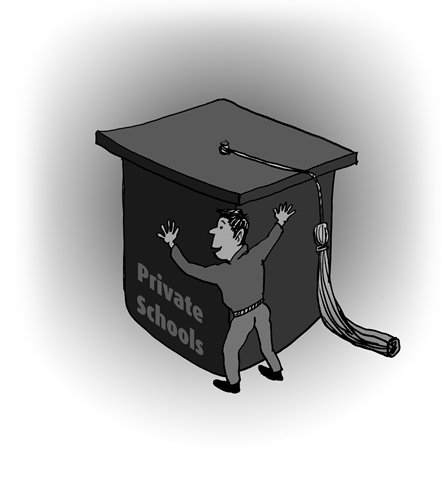
Illustration: Luo Xuan/GT
Education - especially primary and secondary schooling - is perhaps the most-discussed topic in Pakistan. Poor education has not only hindered the country's efforts to eradicate poverty and boost growth, but has also exacerbated issues like gender inequality, social conflicts and even terrorism. For an ethnically and socially diverse country like Pakistan, education carries heavy political significance for nation-building, as it builds common symbols and values.
Even though the provision of free and compulsory education for all children from 5-16 years old is mandated in the Constitution of Pakistan, the reality has long been lamentable, if not outright atrocious. A high drop-out rate in lower grades, a low graduation rate at higher grades, and the gender difference in enrollment which is even wider than that of Afghanistan have bedeviled education in Pakistan. For example, most Pakistani children drop out of school by the age of 9 and only 3 percent complete the 12th grade.
Despite the Pakistani government's commitment to both Millennium Development Goals (MDGs) and Education for All (EFA), there were still more than 22.6 million children out of school in late 2016. More seriously, those in school suffered badly from teacher absenteeism and poor learning environments.
Poor education naturally leads to miserable student performance: Only about half of Pakistanis who complete five years of primary education are literate, and only just over 40 percent of third-graders from rural schools demonstrate passable arithmetic skills like subtraction and addition. Facing the likely scenario of their children learning nothing despite years in school, many parents decide to make the children help in the fields instead.
The Pakistani government, both at central and provincial levels, has undertaken major policy efforts to improve the coverage and quality of education. The education authority was devolved from the federal government to the provinces in 2010, and most provinces have more than doubled their education budgets since then. Impressively, in 2016 Pakistani provinces spent as much as 17 to 28 percent of their budgets on education agendas, whereas the global average was merely 14 percent.
However, despite growing financial resources and political capital being directed into the education system, the results remain largely uncertain. After all, given the fact that Pakistan's education problems are firmly rooted in the country's deeper social and political soil, it will not be easy to make progress.
What Pakistan needs is to spend better, not simply to spend more. The political element in education spending is so strong that increased budgets are often translated into jobs as political patronage, rather than yielding improvements in education. The logic is straightforward: Politicians hand out permanent teaching positions in exchange for their constituents' votes and loyalty, while these teachers function as the patron's political organizers.
In a sense, swelling the ranks of teachers appears to "kill two birds with one stone" for politicians: it appears to address educational problems, helping them to win over more supporters, and it buttresses their personal political base. It's no surprise that education departments have become the single largest employers in most provinces. Strikingly, Pakistan's educational sector is now as big as its armed forces, and the education budget of $8.6 billion in 2016 came second only to the $8.7 billion military bill.
As more and more over-paid teachers enter schools with patronage shielding them from any potential disciplinary proceedings, not only will existing issues like teacher absenteeism get worse, other much-needed social programs may also suffer from insufficient resources.
Could privatization provide a solution? In Pakistan, private schools now host almost 40 percent of all students in primary and secondary education. Perhaps due to the direct accountability relationship developed between the teachers and the parents who pay fees, private schools in general offer higher-quality education with manageable costs. Many provincial governments have tried to outsource public schools to public-private-partnerships through newly established semi-autonomous education foundations. For instance, by 2016, Punjab had handed over 1,000 schools to NGOs like the Citizens Foundation and will further privatize the rest if these experiments have positive outcomes.
Given that Pakistan's education has been distorted by mismanagement and political patronage, privatization seems to provide a decent solution, as it at least translates fiscal resources into tangible outcomes. However, what this private sector-oriented method will deliver in the long run remains largely uncertain.
Effective education reform in Pakistan will require more nuanced and incremental efforts, as well as some patience. After all, only when one generation is educated well can it build a better teaching force for the next.
The author is a researcher with the Pangoal Institution. bizopinion@globaltimes.com.cn
